Disclosure: Meeple Mountain received a free copy of this product in exchange for an honest, unbiased review. This review is not intended to be an endorsement.
The titular characters of The Smurfs, a franchise with a long and interesting history, first appeared in print in 1958 in a comic book created by the Belgian artist Peyo. Originally appearing as side characters in one of his other projects, they proved to be so popular that Peyo continued developing the characters, giving them their own series. Eventually, The Smurfs made their way to the small screen. A series of episodes, created for Belgian television, was produced between 1961-1967, but it wasn’t until Hanna-Barbera picked up the IP in 1981 that The Smurfs really came into its own. This is The Smurfs that we know and love—assuming you’re familiar with it.
In case you’re unfamiliar, the series is centered around a community of small, blue humanoid creatures that stand roughly ‘two apples high’. At the heart of each episode is a story of individuals learning to work together to solve problems much bigger than themselves. (Oftentimes problems that are direct results of their own mischief) Most of their trials and tribulations are due to internal strife—the clashing of personalities or disagreements over how they believe things should be done. However, there is one external influence that is prevalent above all others: the evil sorcerer Gargamel, along with his familiar, a cat named Azrael. Gargamel’s intentions for the Smurfs range from wanting to eat them, wanting to use them as reagents in his alchemical pursuits, or wanting to wipe them out entirely for no reason other than he doesn’t like them very much. His ambitions are perpetually stymied by his own incompetence and the cleverness of the Smurfs themselves. They may be tiny and blue, but they always manage to stay one step ahead, remaining hidden from Gargamel despite his best efforts to find them.
Overview
Designed by Team Kaedama (the design quartet behind titles such as Tokaido and Draftosaurus), The Smurfs: Hidden Village game imagines a world where Gargamel has finally succeeded in locating their homestead, forcing them to flee lest they be captured. Tired of being on the run, and with their old village abandoned, the Smurfs are attempting to put down roots in a new location. But there are obstacles in their path. For starters, many of the Smurfs have gotten separated, lost in the woods, and are in dire need of rescue. As if that weren’t bad enough, sensing victory finally within his grasp, Gargamel is stepping up the pressure, doing everything he can to put an end to the Smurfs forever.
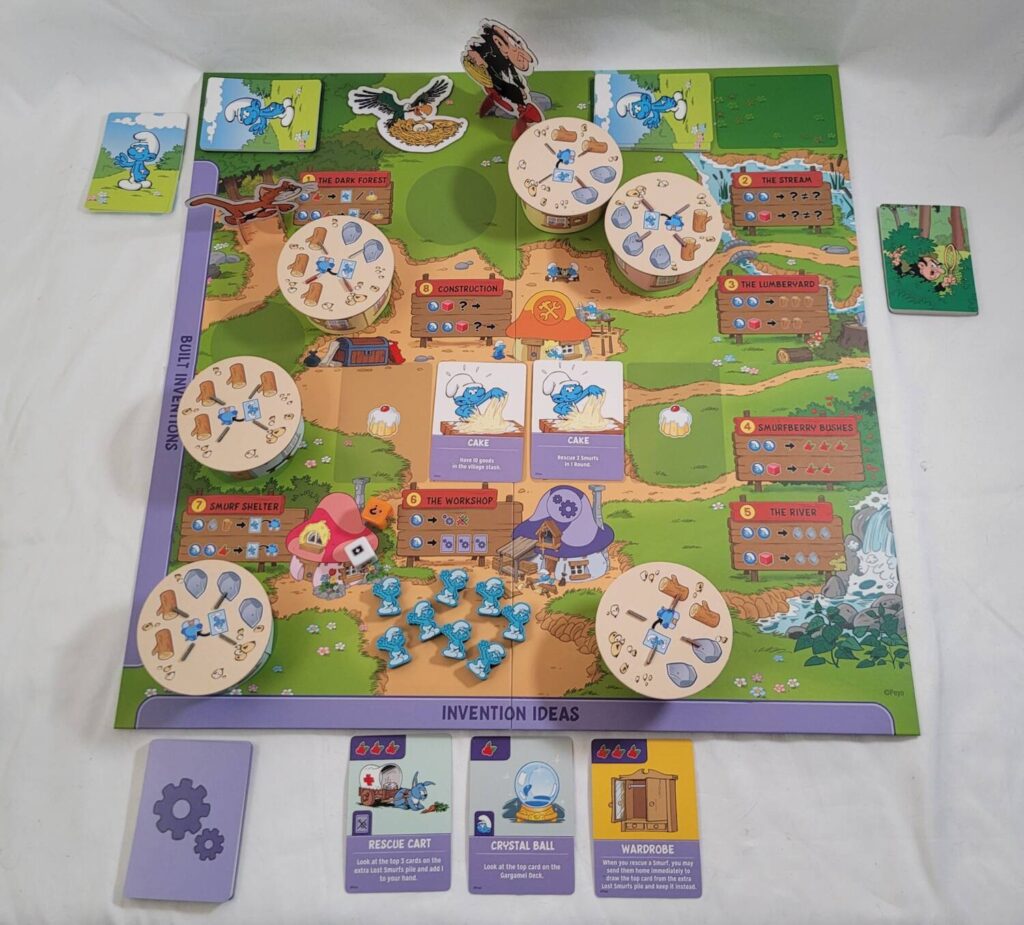
The Smurfs: Hidden Village is a cooperative game. Players begin the game with several Smurf cards drawn from a communal deck. These cards are used to send the Smurf meeples out to the various areas of the game board in order to perform actions such as collecting resources or using those resources to build things. In order to win the game, the Smurfs must accomplish three goals: rescue all the lost Smurfs from the Dark Woods, build some houses, and bake several cakes. The number of Smurfs to rescue, houses to build, and cakes to bake are dependent upon the chosen game difficulty.
Bad Omens
As the game begins, things are looking pretty dire for the players. The deck (a literal deck of Gargamel cards) is stacked against them. This deck is composed of ten or eleven cards (depending on the difficulty), with one of the bottom three cards being a ‘Game Over’ card. If this card is ever flipped up, the players immediately lose. Like any cooperative game where random ‘bad things’ happen, sometimes those bad things aren’t too bad. Whether it is out of preparedness on behalf of the players or sheer dumb luck, sometimes a card flips up that doesn’t really affect you (being forced to lose all of your wood when you don’t actually have any, for instance). Typically, though, Gargamel’s misdeeds will throw a wrench into the works, costing the players valuable resources, time, or some mixture of the two. Sometimes, a Gargamel card may actually wind back progress the players have already made.
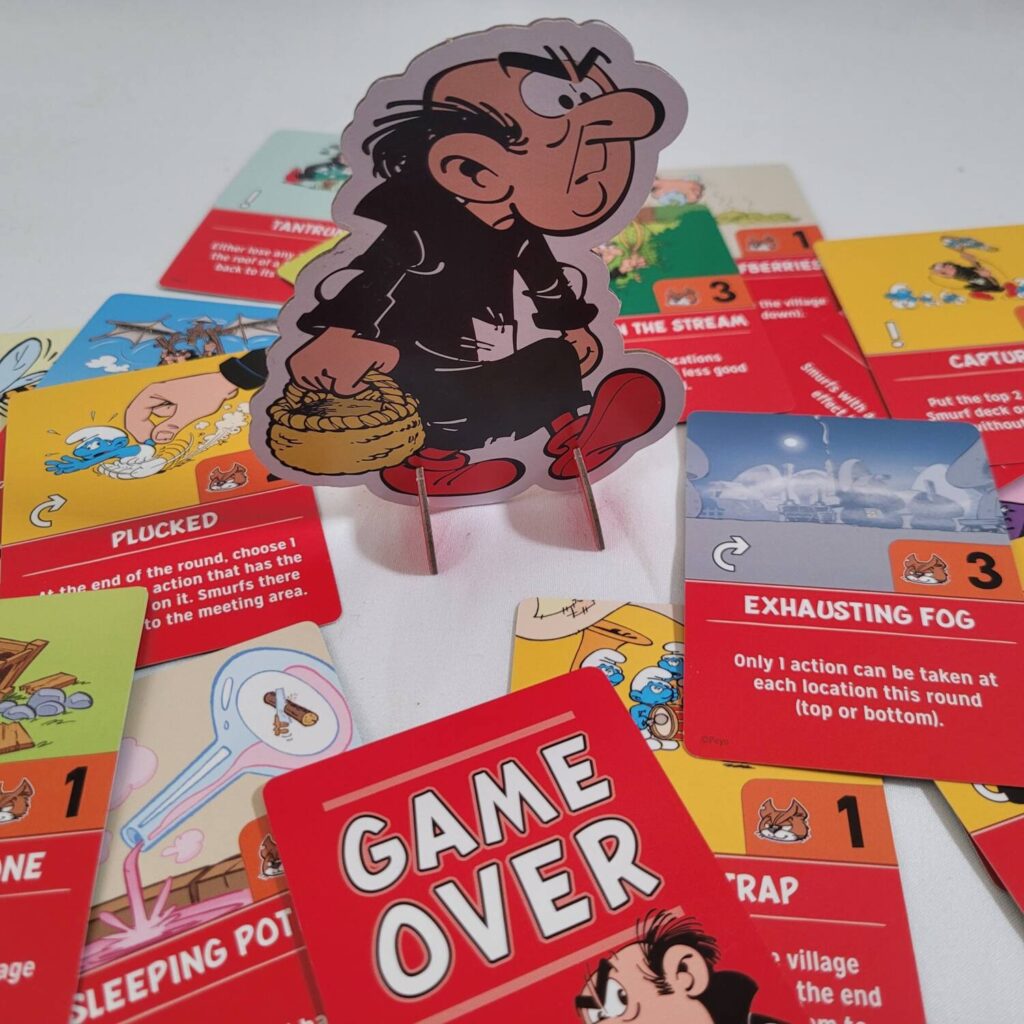
Each Smurf card features a unique Smurf with its own special qualities. At the start of the game, the Smurfs the players have to work with are pretty terrible, each having some built-in drawbacks. However, there are methods in place for the players to change this. For instance, Smurfs rescued from the Dark Woods are added to the players’ hands immediately upon rescue. These Smurfs have no drawbacks, making them valuable additions to the communal deck. Also, there is one action the players may take in order to ‘send a Smurf home’, housing an unwanted Smurf card for the rest of the game (a.k.a. thinning the deck). This action is also a free action as a result of successfully building a house.
Each round consists of players playing a card from their hand and doing whatever it says, taking an action with a Smurf meeple, and then drawing back up to their maximum hand size (shuffling the discard pile to form a new deck if the draw pile runs out). In addition to their one action they may perform during their turn, players may also perform one or more of the game’s two free actions: build an invention and/or bake a cake. Once all the Smurf meeples have been played out, the round ends, and a new Gargamel card is drawn. In addition to the negative effects introduced by the newly drawn Gargamel card, this will cause the Azrael standee to move to a new location.
If a player ever takes an action at the location where Azrael is, they must roll the Azrael die before they perform their action. This die is generally unfriendly, forcing players to discard cards and resources, but has the potential to be helpful as well (since Azrael, like his master, can be a bumbling imbecile at times). In addition to this, one face of the Azrael die may cause an available Smurf meeple to be taken away to the Hungry Howlibird’s nest. Depending on the chosen game difficulty, this Smurf may be released to the worker pool during end-of-round cleanup or it may be stuck there permanently until players make an effort to rescue it.
Out of all the setbacks in this game, the loss of a worker to the Howlibird is the one that hurts the most. The action economy in The Smurfs: Hidden Village is tight, especially if you’re playing at a higher difficulty. There are only eight Smurf meeples to go around, with a possible ninth that may be unlocked later. Eight Smurfs may sound like a lot, but if you consider some actions require two Smurfs in order to use them, you’ll realize that it’s easy to run out of Smurfs before you’ve made any real progress towards completing one of your goals.
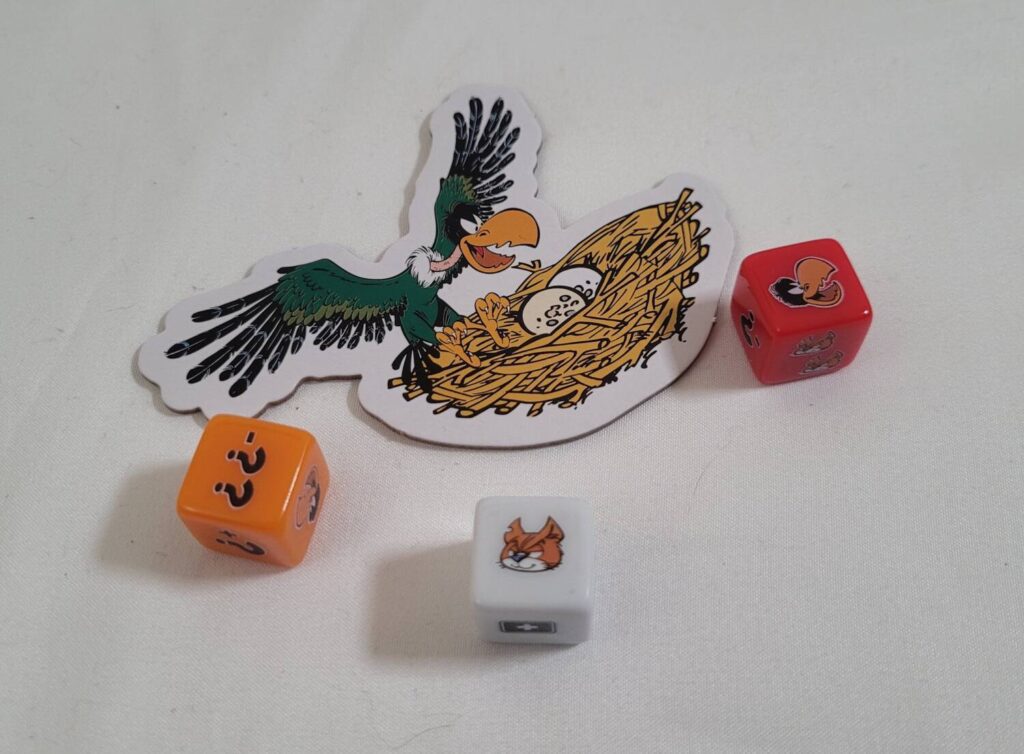
Another setback is the Danger die. There are actually two of these included in the game, a white one and a red one (called ‘the mega Danger die’). The white Danger die is mostly harmful to the players, although it does have at least one helpful face. The mega Danger die, on the other hand, is completely negative. It is entirely possible that you may be forced into a situation where you have to play a starter Smurf from your hand which forces you to roll the Danger die, and then have to roll the Danger die a second time due to where you’ve placed the Smurf meeple. And, if Azrael happens to be in that location? Well, you’ve got to roll that die as well. If Lady Luck is on your side, you might escape such a situation relatively unscathed. But if she isn’t? Well, you may find yourself down three Smurfs due to multiple Howlibirds in a row…a nightmare-inducing situation, indeed!
You Can’t Keep a Good Smurf Down
Don’t let the cutesiness fool you. The Smurfs: Hidden Village is a co-op game that’s as tough as they come. But it’s not all doom and gloom. The Smurfs are resilient and resourceful with a lot of tricky and useful Inventions up their non-existent sleeves. During setup, several random Invention cards are drawn from their deck and placed into the Invention Ideas area at the bottom of the game board. As a free action on their turn, a player may spend a number of smurfberries to build one of these and add it to the Built Inventions area. There is a maximum of four Inventions that may be built at any time, but players can choose to replace already built Inventions in favor of others. These Inventions provide the players with useful benefits such as new action spaces, the ability to scry and rearrange the Gargamel deck, the ability to outright ignore the negative ability of a flipped up Gargamel card, or the ability to unlock a ninth Smurf meeple (among many others).
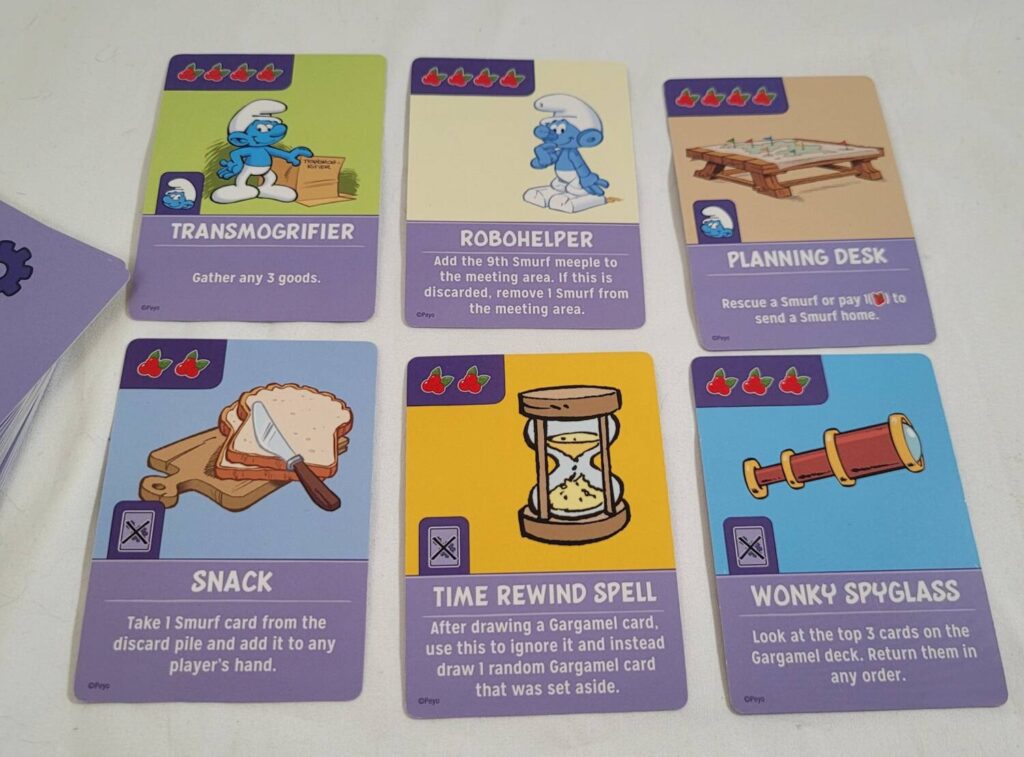
The Smurfs: Hidden Village is a game that fosters, and thrives on, good communication and planning. Earlier, I mentioned the player option of baking a cake. This is the second free action, and it’s a critical step towards winning the game. Each cake has a set of criteria that need to be met in order for the cake to be flipped to its baked side. The criteria include things such as “Build 2 houses in a single round”, “Have 10 goods in the village stash”, and “Take 4 dangerous actions (actions that require you to roll the Danger die) in a row”. Some are far more difficult than others to accomplish, but all will require a great deal of teamwork and strategy to pull off.
In Summary
When Meeple Mountain was first offered a copy of The Smurfs: Hidden Village for review, there were several factors that convinced me to put my hand up. First and foremost, my son (just a few months shy of seven years old) has lately become obsessed with The Smurfs. I figured he might be willing to give it a go considering the I.P., and I was right. Even though the suggested age range on the box is eight years old and up, I find that he’s pretty much able to grasp everything that’s going on and contributes in a meaningful way. The entry for the game on BGG suggests a 25-35 minute playtime, but I find the playtime to be much closer to an hour. While it may not seem like it at first glance, there are a lot of moving parts and a lot of decision points to consider. I find that his attention span begins to wane around the 45 minute mark, and it can become difficult to keep him focused. So, if you’re the parent of young children with short attention spans and you’re looking for a good co-op game to play with them, this may not be the game for you. If that does describe you, I recommend Zombie Kidz as a better alternative.
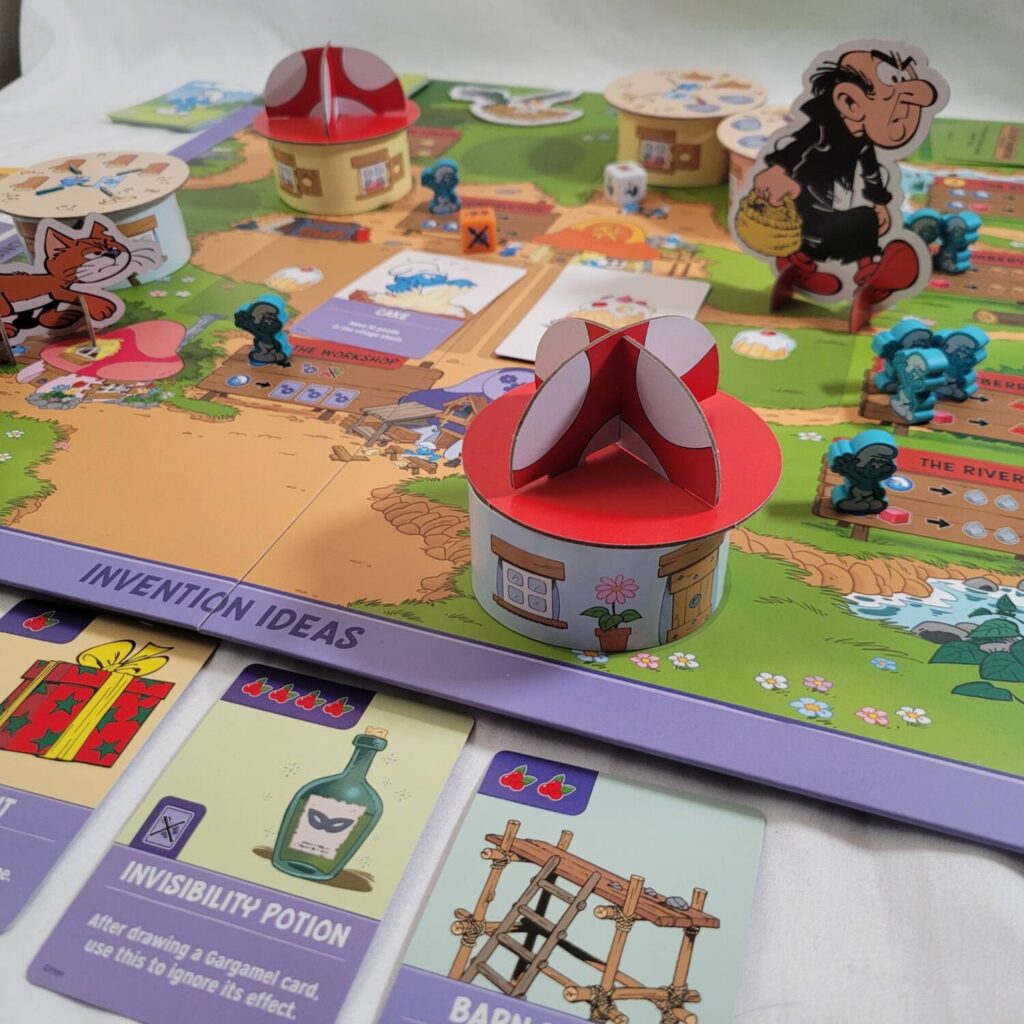
The second thing that caught my attention was the designer pedigree. Knowing this was a Team Kaedama design, I knew that this game was going to be more than just an I.P.-driven cash grab. I knew that I would be getting a quality game that not only looked good, but would also play well. And, I’m happy to say that The Smurfs: Hidden Village exceeded all of my expectations. This is a game that is easily customizable, able to be ramped up depending on your skill level and how much suffering you can endure.
Played at its easiest level, The Smurfs: Hidden Village is an enjoyable frolic through the woods. There are fewer Smurfs to rescue, fewer houses to build, and fewer cakes to bake. The Gargamel deck is a bit larger. Time is on your side. But, at its most difficult mode, winning a game of The Smurfs: Hidden Village feels like a nigh impossibility, often coming down to the wire, hoping and praying for just one more round before the dreaded Game Over card appears. I really appreciate how these vastly different experiences emerge as a result of shuffling a couple of extra cards into a deck and swapping out a die.
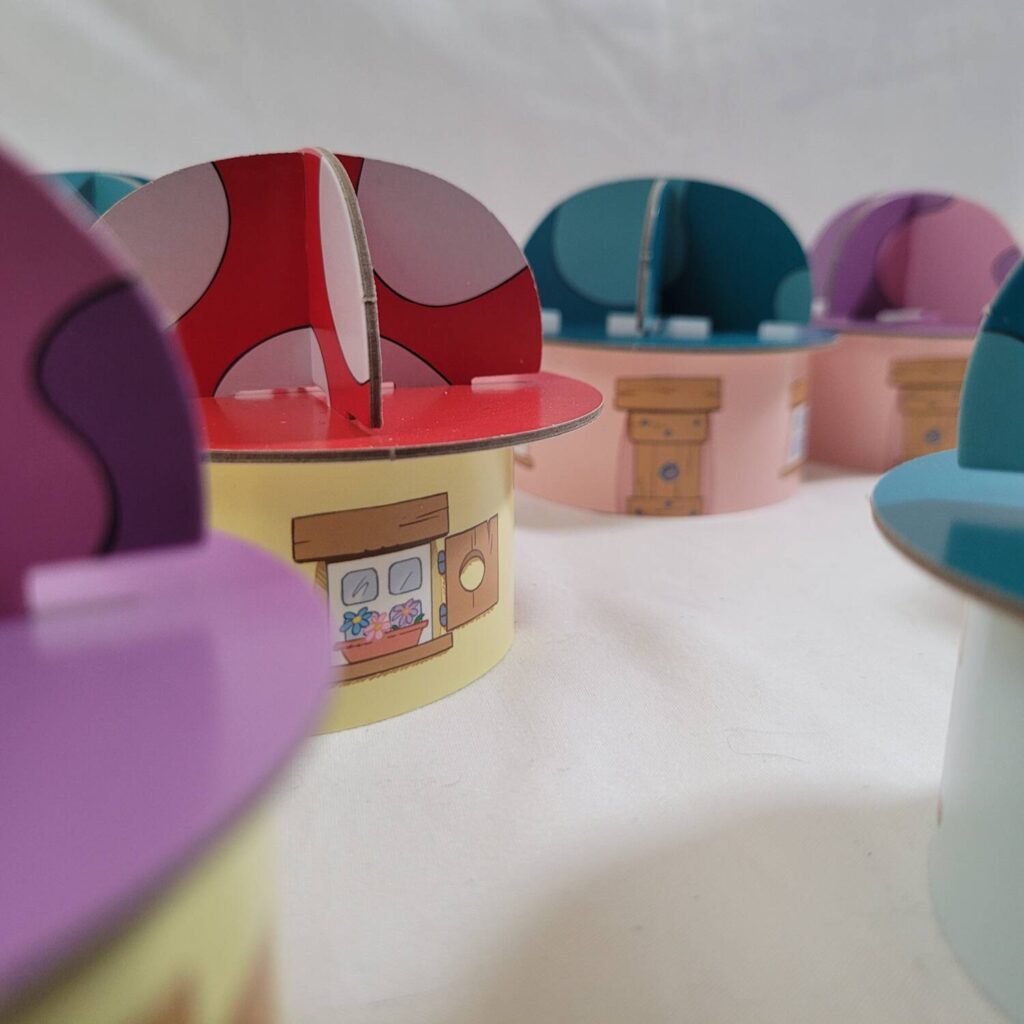
My only real complaint about the game—and not much of one, honestly— is in regards to how the houses store inside of the box. Each house is constructed of a printed strip of paper, taped together at either end to form a ring, and a cardboard roof component that sits on top of it. During the game, this roof is flipped downwards such that the domed portion of the roof is nestled inside of the ring with the flat side facing up, displaying the costs associated with building it. Once the house is built, the roof is flipped over with the dome side up. While these houses are a nice thematic touch, they’re bulky and collectively take up most of the box’s real estate. As such, storing the other components is a bit of a challenge.
When I first cracked the lid on this game, I wasn’t prepared for how challenging it was going to be. I also wasn’t prepared for how addictive it would become. And I certainly wasn’t prepared for how much I was going to like it. My final judgment?
This game is smurftastic!


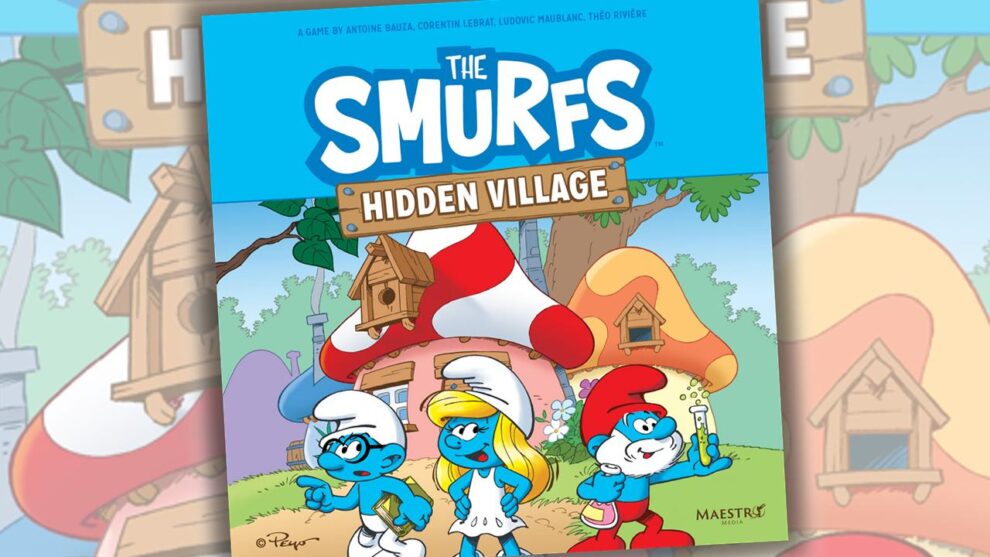









Add Comment